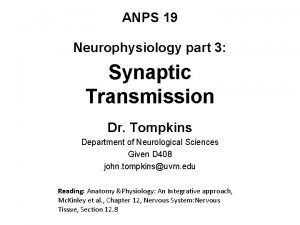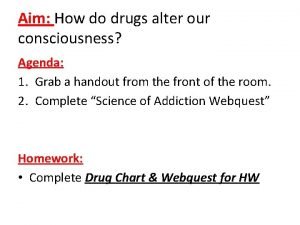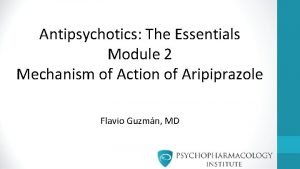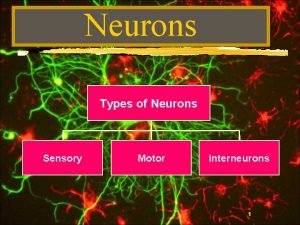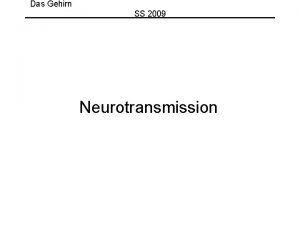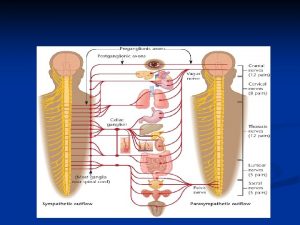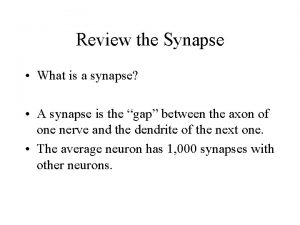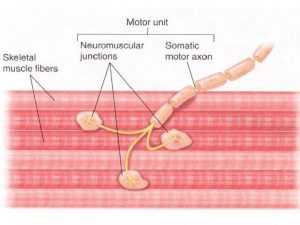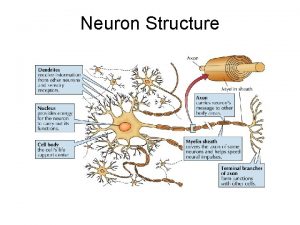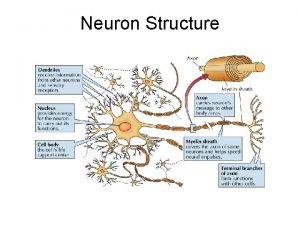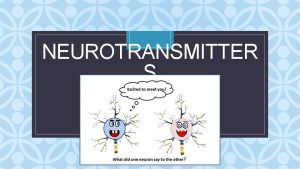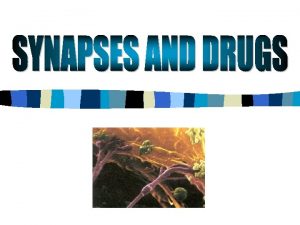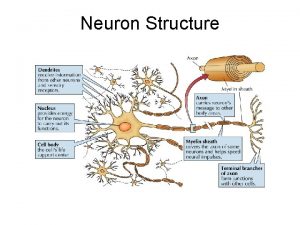Neurotransmission Across a Synapse pp 323 The Synapse











- Slides: 11

Neurotransmission Across a Synapse pp. 323

The Synapse Why are Synapses Important? A SYNPASE is specialized region at the ends of axons that allow one nerve cell to communicate & transmits an impulse across to another cell.

Synapse Anatomy A. SYNAPTIC KNOB (a. k. a. axon bulb): small swelling at the ends of axons B. PRESYNAPTIC MEMBRANE: the membrane of the axon bulb C. POSTSYNAPTIC MEMBRANE: the membrane of the dendrite D. SYNAPTIC CLEFT: the space between the presynaptic and the postsynaptic membranes E. NEUROTRANSMITTER SUBSTANCES (neurotransmitters): chemicals that transmit the nerve impulses across a synaptic cleft. F. SYNAPTIC VESICLES: found near surface of synaptic endings & contain the neurotransmitters


Synaptic Transmission A. An action potential reaches the axon bulb B. Ca 2+ gates in bulb membrane open & calcium ions move into bulb C. Entry of Ca 2+ stimulates the synaptic vesicles to move to the presynaptic membrane. D. They fuse with the membrane, emptying the neurotransmitter into the synaptic cleft by exocytosis

E. Neurotransmitters diffuses across the cleft & bind to receptors on the postsynaptic membrane of the next neuron’s dendrite. F. The action of binding the neurotransmitters initiates or suppresses an action potential in the postsynaptic neuron NOTE: Impulses can only go one way across the gap because only the axon has the vesicles & the dendrite only has the receptors.

Neurotransmitters Breakdown A. Inactivating neurotransmitters are important to clear the synaptic gap for the next signal from the presynaptic neuron. B. Methods to remove neurotransmitters: 1. Enzymes in the postsynaptic membrane or synaptic cleft break apart the neurotransmitter (e. g. acetyolcholinesterase or ACh. E) 2. Reabsorption by axon bulb for breakdown or repackaging/reuse.


More About Neurotransmitters • Most are EXCITATORY – their binding opens Na+ channels & creates or encourages action potentials. • Some are INHIBITORY – their binding stops action potentials.

• Excitatory transmitters include 1. 2. 3. 4. Acetylcholine (ACh) Adrenalin (epinephrine) Noradrenalin (norepinephrine or NE) Serotonin (derived from the amino acid tryptophan) 5. Dopamine • Inhibitory transmitters include 1. 2. 3. • GABA (gamma aminobutyric acid - a type of amino acid) Glycine (an amino acid) Serotonin can also act as an inhibitory neurotransmitter. Exact action depends more on the receptor than on the neurotransmitter. Ex) Serotonin can be excitatory or inhibitory in different circuits.

Drugs Affect on Neurotransmitters • Proper brain & nervous system function depends on the proper balance of excitatory & inhibitory synaptic transmitters. • drugs act by imitating, stimulating, or blocking the effects of certain neurotransmitters
